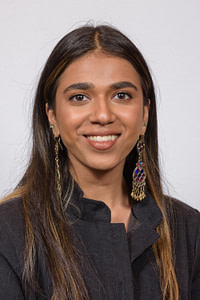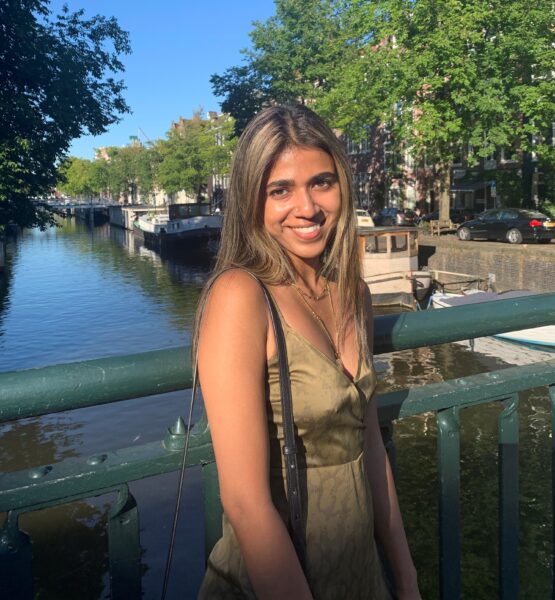Originally published on Psychology Today
December 27, 2021
Part I: How Yamini Rajan overcame barriers to seek help.
KEY POINTS
- Immigrants, especially youth, can experience serious challenges to their emotional stability.
- Having a counselor to mediate a difficult conversation with parents can be life-saving.
 ML: Yamini, you began to experience anxiety, depression, and self-harm pretty young. What were the barriers to seeking help?
ML: Yamini, you began to experience anxiety, depression, and self-harm pretty young. What were the barriers to seeking help?
YR: I lived in India until I was 12; I didn’t know there was help. It’s not something that’s really talked about. I didn’t know that you weren’t supposed to feel that way. I just thought it was normal for a long time. Things built up to a breaking point. We moved to the US, and my mom was diagnosed with cancer about three months after. It was difficult being so young and halfway across the world and trying to figure out how to fit into a new school, who were going to be my friends. There were new teachers and an entirely new culture that I tried to navigate. My parents weren’t able to be as present as they would have liked because they had to focus on my mom’s health. I was very lonely, angry, and sad all at the same time. I didn’t want to say anything because the move wasn’t just tough on me; it was tough for my little sister who started at a new elementary school. My father started work. My parents were in their 40s; it’s not easy for anyone.
What if I did speak up and no one understood? What if I was told I was being too sensitive? In my head, I thought: ‘My mom has cancer; I just feel sad. How can I go to her and say: Hey I know you are going through something right now, but I need help?’ It didn’t feel important. I didn’t think anyone else would think it was real. I think a lot of immigrants go through that struggle of finally arriving here and not wanting to do anything to mess it up. They don’t want to rock the boat. They just want smooth sailing, to make it, and be successful. I didn’t know that therapy or medication or any of those things were options. My only experience with mental health was with the media. That wasn’t a picture that I identified with. I didn’t want to be a stereotype. These problem kids, juvenile delinquents with severe mental health issues acting crazy, and it’s really not true for the majority, but I didn’t learn that until much later.
ML: How did you determine who you were going to open up to about the thoughts and feelings that were destroying your quality of life? At what point did you say that your pain needed to be addressed?
Not Being Able to Handle Big Feelings Alone Isn’t a Mark of Failure
ML: Yamini, you began to experience anxiety, depression, and self-harm pretty young. What were the barriers to seeking help?
YR: I lived in India until I was 12; I didn’t know there was help. It’s not something that’s really talked about. I didn’t know that you weren’t supposed to feel that way. I just thought it was normal for a long time. Things built up to a breaking point. We moved to the US, and my mom was diagnosed with cancer about three months after. It was difficult being so young and halfway across the world and trying to figure out how to fit into a new school, who were going to be my friends. There were new teachers and an entirely new culture that I tried to navigate. My parents weren’t able to be as present as they would have liked because they had to focus on my mom’s health. I was very lonely, angry, and sad all at the same time. I didn’t want to say anything because the move wasn’t just tough on me; it was tough for my little sister who started at a new elementary school. My father started work. My parents were in their 40s; it’s not easy for anyone.
What if I did speak up and no one understood? What if I was told I was being too sensitive? In my head, I thought: ‘My mom has cancer; I just feel sad. How can I go to her and say: Hey I know you are going through something right now, but I need help?’ It didn’t feel important. I didn’t think anyone else would think it was real. I think a lot of immigrants go through that struggle of finally arriving here and not wanting to do anything to mess it up. They don’t want to rock the boat. They just want smooth sailing, to make it, and be successful. I didn’t know that therapy or medication or any of those things were options. My only experience with mental health was with the media. That wasn’t a picture that I identified with. I didn’t want to be a stereotype. These problem kids, juvenile delinquents with severe mental health issues acting crazy, and it’s really not true for the majority, but I didn’t learn that until much later.
ML: How did you determine who you were going to open up to about the thoughts and feelings that were destroying your quality of life? At what point did you say that your pain needed to be addressed?
Not Being Able to Handle Big Feelings Alone Isn’t a Mark of Failure
YR: I didn’t actually tell anyone what I was going through until after my suicide attempt when I was 12. My best friend in middle school also had severe mental health issues, and we bonded over that. Neither of us could talk to our parents; we talked to each other. It was scary: Two 12-year-old girls dealing with a lot of big feelings, trying to counsel each other. It could have gone horribly, looking back on it now that I’m 21. The conversations we were having were really scary. We engaged in some unhealthy coping mechanisms like skipping class and taking drugs, and hanging out with people who were a lot older than us who didn’t necessarily have the best intentions. It wasn’t until after my suicide attempt that it became a lot more than I could handle, but I still couldn’t tell my parents, because they’d be so disappointed in me. I felt like such a failure because I couldn’t deal with it on my own. I didn’t know who to go to. I didn’t think talking to my parents was an option, not because I thought they’d get angry, but more because I didn’t want to cause them anymore hurt. My mom had just gone into remission. It was supposed to be a happy time. I didn’t want to be another crisis. I was looking around and I didn’t have that many adults in my life at that time who I trusted. I was getting closer to my school counselor, Mr. Everson. My friend suggested I talk to him. I used to go with her and be on the sidelines, but I’d seen the way he never made her feel judged. That’s what I was looking for. I didn’t want anyone to judge me. I went to Mr. Everson and he asked me how long I’d been dealing with it. It was the first time anyone had ever asked me that.
Once I started talking, I couldn’t stop. I wasn’t being questioned or interrogated. He did say he had to tell my parents. I said OK, but I didn’t want to be in the room when he told them. I’m grateful he facilitated that conversation and I’m sure my parents would say the same. I think we needed a moderator there. As new as it was for me, it was new for them. In the same way, I didn’t know anything about mental health awareness. What is depression, what is anxiety, can 12 year-olds have that? My parents didn’t know either. They also had a huge cultural barrier to mental health education. They didn’t know about it or that they had to teach us about it. Mr. Everson helped us understand what was going on and how to keep going. He connected my parents to my therapist. It took a lot of thought of who I was going to talk to. I’m glad about the decision I made and I’m glad I didn’t go to my parents first.
Check back for Part II when Yamini discusses identifying and overcoming her painful thoughts and feelings and the changes she’s made from then until now.
Click here to read the original article.
Originally published on Psychology Today
January 5, 2022
Part II: Interview with Yamini Rajan on immigration and mental health.
KEY POINTS
- It’s important that people acknowledge their feelings and see mental health as a work in progress.
- It’s OK to take up space.
- Reaching out for help isn’t a sign of weakness.
ML: How do your everyday thoughts and feelings compare to what they were when you were going through the crisis? If the old patterns still surface, how do you meet them head-on?
YR: When you hear storytellers, it’s easy for the audience to think they went through something, and now they’re on the other side. It’s so not true. That was my rock bottom, and I still deal with these issues in so many different ways. I had an eating disorder; I was self-harming; I had chronic insomnia. All of those things contributed to how horrible I felt all the time.
Now I deal with a lot more anxiety. The depression is still there, but I know when I’m about to slip down and how to manage it. I recognize when I don’t sleep well, or I get more anxious during the day. I know to take care of myself.
I didn’t have that self-awareness when I was 12. I didn’t know that not sleeping for three days in a row wasn’t normal and would make me feel more depressed and more anxious. I didn’t know that feeling my heart racing and like I was about to die was a symptom of a panic attack. I know that now. I know to take myself out of a situation.
At 12, I buried all those feelings and tried to avoid them. At 21, acknowledging them and giving them their space is the biggest change I’ve made in my life. I have my parents to talk to; I have friends, my boyfriend, and my sister. I have so many things in my life that are much more than periods of sadness. That change in mentality is what’s kept me going for this long. I haven’t had thoughts that are as bad as they were, and I credit therapy for that.
ML: You’re more experienced with them. If the thoughts and feelings of harming yourself or attempting suicide were a character in a story, what does it look like, say, and feel like?
YR: Wanting to self-harm came from a lack of control. I was 12. I couldn’t control moving across the world, or my mom’s cancer, or the fact that I felt I didn’t fit in at school. I was the only immigrant. I didn’t have control over the school I went to, or the classes I had to take, or anything really. I could only control when I self-harmed, how I self-harmed, what I ate, when I ate, whether I wanted to kill myself. So I hyper-fixated on it. I could control when I cut, and it was mine. It was scary.
I thought that was a healthy expression of my feelings and doing what I could to fix the problem. I thought that’s how people got better. I was on Tumblr at the time. It was a dark and scary place to be in the early 2010s. Blogs called “Pretty Girls Don’t Eat.”
For me, as an immigrant who didn’t necessarily fit the beauty standard, I internalized that. Maybe if I weighed ten pounds less, maybe I’d feel good about myself. It was a huge issue with trying to control myself and trying to disappear so I could take care of myself. If I ever did get back to that point, I hope I’d recognize that now.
Give yourself permission to exist and take up space.
ML: How do you take up space now?
YR: By not apologizing for being myself. Even past middle school, feeling bad for thinking my thoughts or having an opinion. I tried to be neutral always, but you can’t live your life being neutral.
You have to have a stance. Saying what you need to say and having an opinion that doesn’t harm anyone is OK. I needed to learn that. Now, I will say what I think, and I’m very blunt and straightforward. That’s such a big change from who I was at 15 and 16.
ML: Yes, giving yourself permission to exist, to take up space, to speak and feel is huge.
YR: Expressing anger was such a challenge for me. I wouldn’t let myself get angry even if someone hurt me. I didn’t want to make them feel bad. I learned that I’m allowed to be angry. It was freedom with a huge learning curve for me.
ML: That control might be a common theme. When people lose their temper, they can lose control and lash out. You’ve shared your story through the Grit and Grace Conference from ASHA International and theimmigrantstory.org. What do you want readers to get out of hearing your story?
YR: So when I first joined ASHA, I was the youngest or second youngest and the only youth storyteller of color. That was important to me and to Gayathri (ASHA International’s founder). We knew how much pain the Southeast Asian community faced. I saw all my peers dealing with anxiety, stress, and depression, but they were afraid to say anything because they didn’t think their parents would accept it. The idea of having a therapist wasn’t considered a medical treatment.
There are people and kids facing so much and not being able to say it out loud. I especially want Southeast Asian youth to know that this is valid. They’re not less than or weak or unable to handle stress.
You see the trauma and sacrifices their parents have made to get to where they’re at. I want my story to help people know that they can be successful, amazing, the best of the best while still admitting they have issues, trauma, and stress in their life. That doesn’t make them less deserving of being here or make their parents’ sacrifice useless. They can’t perform at the level they want to be at if they’re tired and stressed all the time and up all night thinking anxious thoughts. I don’t think I would have gotten to where I’ve gotten life if I hadn’t admitted at 12 that I had an issue.
 ML: I think you’re right. There actually is no success if you don’t have the tools, resources, expertise, and knowledge to handle those crises.
ML: I think you’re right. There actually is no success if you don’t have the tools, resources, expertise, and knowledge to handle those crises.
YR: Healing is a community effort. No one can do it on their own. You can’t heal yourself when you’re broken. Mental health is so stigmatized in our society. Some people think it’s for the weak, but that mentality stops so many people from saying they need help. That’s what I want my story to represent.
ML: Because that’s how you get the help—by reaching out. What’s next for you?
YR: I’m finishing my junior year at George Washington University in D.C. Who knows what’s next for me? Hopefully, a job. I’m a criminal justice and psychology major. I would like to go to law school and find an intersection between the two. I’m wide open and excited to see what I want to do!

